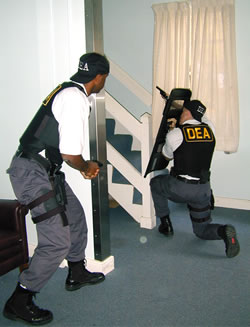Drug prohibition
(Redirected from Illicit drugs)
Drug prohibition is a legal framework that seeks to reduce the consumption of certain psychoactive substances by making their manufacture, distribution, possession, and use illegal. This approach is often implemented with the intention of protecting public health and social order, based on the belief that drugs pose a significant threat to individuals and society as a whole. Drug prohibition laws vary widely from country to country, ranging from the complete banning of all psychoactive substances except those specifically allowed for medical and scientific purposes, to more lenient policies that penalize only the unauthorized sale and distribution of drugs.
History[edit | edit source]
The history of drug prohibition can be traced back to the early 20th century, with the International Opium Convention of 1912 being one of the first international treaties aimed at controlling drug production and trade. This was followed by further international agreements, such as the Single Convention on Narcotic Drugs in 1961, the Convention on Psychotropic Substances in 1971, and the United Nations Convention Against Illicit Traffic in Narcotic Drugs and Psychotropic Substances in 1988, which have shaped the global legal framework for drug prohibition.
In the United States, the Harrison Narcotics Tax Act of 1914 marked the beginning of drug prohibition policies, initially targeting opium and coca derivatives. The Controlled Substances Act (CSA) of 1970 then established a scheduling system to classify drugs based on their potential for abuse and medical value, laying the groundwork for the war on drugs.
Arguments for and against[edit | edit source]
Supporters of drug prohibition argue that it is necessary to protect individuals from the harmful effects of drugs, which can include addiction, physical harm, and death. They also claim that drug prohibition helps to reduce crime associated with drug trafficking and use, and protects young people from experimenting with drugs.
Critics of drug prohibition, however, argue that it has failed to significantly reduce drug use and has instead led to a range of negative consequences. These include the criminalization of drug users, the creation of a black market for drugs that fuels organized crime and violence, and the diversion of resources from harm reduction and treatment programs to law enforcement. Some advocates for reform call for a shift towards a more health-oriented approach, including the decriminalization or legalization of certain drugs, and the implementation of harm reduction strategies such as safe injection sites and drug education programs.
Current Trends[edit | edit source]
In recent years, there has been a growing movement towards drug policy reform, with some countries and states adopting more liberal policies. For example, several jurisdictions have decriminalized or legalized cannabis for medical or recreational use, and others have implemented harm reduction measures such as needle exchange programs and supervised consumption sites. However, drug prohibition remains the dominant approach to drug policy in many parts of the world.
See also[edit | edit source]
Transform your life with W8MD's budget GLP1 injections from $125
W8MD offers a medical weight loss program NYC and a clinic to lose weight in Philadelphia. Our W8MD's physician supervised medical weight loss centers in NYC provides expert medical guidance, and offers telemedicine options for convenience.
Why choose W8MD?
- Comprehensive care with FDA-approved weight loss medications including:
- loss injections in NYC both generic and brand names:
- weight loss medications including Phentermine, Qsymia, Diethylpropion etc.
- Accept most insurances for visits or discounted self pay cost.
- Generic weight loss injections starting from just $125.00 for the starting dose
- In person weight loss NYC and telemedicine medical weight loss options in New York city available
- Budget GLP1 weight loss injections in NYC starting from $125.00 biweekly with insurance!
Book Your Appointment
Start your NYC weight loss journey today at our NYC medical weight loss, and Philadelphia medical weight loss Call (718)946-5500 for NY and 215 676 2334 for PA
Search WikiMD
Ad.Tired of being Overweight? Try W8MD's NYC physician weight loss.
Semaglutide (Ozempic / Wegovy and Tirzepatide (Mounjaro / Zepbound) available. Call 718 946 5500.
Advertise on WikiMD
|
WikiMD's Wellness Encyclopedia |
| Let Food Be Thy Medicine Medicine Thy Food - Hippocrates |
Translate this page: - East Asian
中文,
日本,
한국어,
South Asian
हिन्दी,
தமிழ்,
తెలుగు,
Urdu,
ಕನ್ನಡ,
Southeast Asian
Indonesian,
Vietnamese,
Thai,
မြန်မာဘာသာ,
বাংলা
European
español,
Deutsch,
français,
Greek,
português do Brasil,
polski,
română,
русский,
Nederlands,
norsk,
svenska,
suomi,
Italian
Middle Eastern & African
عربى,
Turkish,
Persian,
Hebrew,
Afrikaans,
isiZulu,
Kiswahili,
Other
Bulgarian,
Hungarian,
Czech,
Swedish,
മലയാളം,
मराठी,
ਪੰਜਾਬੀ,
ગુજરાતી,
Portuguese,
Ukrainian
Medical Disclaimer: WikiMD is not a substitute for professional medical advice. The information on WikiMD is provided as an information resource only, may be incorrect, outdated or misleading, and is not to be used or relied on for any diagnostic or treatment purposes. Please consult your health care provider before making any healthcare decisions or for guidance about a specific medical condition. WikiMD expressly disclaims responsibility, and shall have no liability, for any damages, loss, injury, or liability whatsoever suffered as a result of your reliance on the information contained in this site. By visiting this site you agree to the foregoing terms and conditions, which may from time to time be changed or supplemented by WikiMD. If you do not agree to the foregoing terms and conditions, you should not enter or use this site. See full disclaimer.
Credits:Most images are courtesy of Wikimedia commons, and templates, categories Wikipedia, licensed under CC BY SA or similar.
Contributors: Prab R. Tumpati, MD







